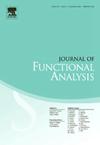量子n体动力学的平均场和半经典极限
IF 1.6
2区 数学
Q1 MATHEMATICS
引用次数: 0
摘要
我们研究了量子多体玻色子动力学的平均场和半经典极限,在R3上具有排斥性δ型势N3βV(Nβx)和排斥性库仑势,从而得到了一个宏观流体方程,即带压力的欧拉-泊松方程。我们证明了量子质量和动量密度在极限方程第一次爆发时间前的定量强收敛性。证明是基于调制能量法,其中一个函数不等式是关键因素。与只考虑库仑势的情况并可以使用Serfaty不等式的Golse-Paul[38]不同[64],δ型势的尖锐奇异性和一般剖面阻碍了此类不等式的应用。本文提出了一种全新的方法,利用Erdős-Schlein-Yau [31], [33], [34] h1型能量估计发挥意想不到的作用,建立了最优情况β∈(0,1)δ型势的泛函不等式。本文章由计算机程序翻译,如有差异,请以英文原文为准。
On the mean-field and semiclassical limit from quantum N-body dynamics
We study the mean-field and semiclassical limit of the quantum many-body bosonic dynamics with a repulsive δ-type potential and a repulsive Coulomb potential on , which leads to a macroscopic fluid equation, the Euler-Poisson equation with pressure. We prove quantitative strong convergence of the quantum mass and momentum densities up to the first blow up time of the limiting equation. The proof is based on a modulated energy method, for which a functional inequality is the key ingredient. Different from Golse-Paul [38] in which the sole Coulomb potential case was considered and one could use Serfaty's inequality [64], the δ-type potential's sharp singularity and general profile hinder the application of such inequalities. In this paper, we develop a completely new method, in which Erdős-Schlein-Yau [31], [33], [34] -type energy estimate plays an unexpected role, to establish the functional inequality on the δ-type potential for the optimal case .
求助全文
通过发布文献求助,成功后即可免费获取论文全文。
去求助
来源期刊
CiteScore
3.20
自引率
5.90%
发文量
271
审稿时长
7.5 months
期刊介绍:
The Journal of Functional Analysis presents original research papers in all scientific disciplines in which modern functional analysis plays a basic role. Articles by scientists in a variety of interdisciplinary areas are published.
Research Areas Include:
• Significant applications of functional analysis, including those to other areas of mathematics
• New developments in functional analysis
• Contributions to important problems in and challenges to functional analysis

 求助内容:
求助内容: 应助结果提醒方式:
应助结果提醒方式:


